Nepal – The Nepal government announced on Monday night that it has withdrawn its decision to ban social media platforms following violent Nepal protests that resulted in at least 19 deaths and over 300 injuries. The dramatic reversal came after widespread demonstrations led primarily by young citizens, collectively known as Gen-Z, escalated into deadly confrontations with security forces.
The Nepal protests erupted after the government blocked 26 social media platforms, including popular sites like Facebook, YouTube, and X, on Friday for failing to register under new regulations. What began as demonstrations against digital restrictions quickly evolved into broader anti-government Nepal protests addressing deeper systemic issues.
Escalation of Violence During Nepal Protests
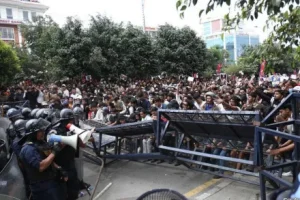
The Nepal protests witnessed severe clashes when demonstrators attempted to breach restricted areas near parliament in Kathmandu. Police responded with bullets, tear gas, water cannons, and batons as protesters pushed through barbed wire barriers and tried to storm government facilities.
Confirming 17 deaths in Kathmandu alone, police reported approximately 400 injuries, including over 100 law enforcement officers. The violent nature of these Nepal protests shocked many participants who had intended peaceful demonstrations. One injured protester, 20-year-old Iman Magar, who was struck in the right arm, expressed surprise at the government’s forceful response to what began as peaceful Nepal protests.
Government Response and Policy Reversal
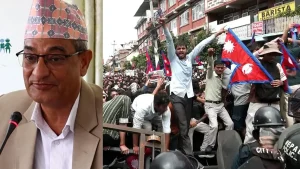

Prime Minister KP Sharma Oli, who leads a multi-party alliance dominated by his Communist party, initially defended the social media restrictions as being “in the national interest.” However, the intensity of the Nepal protests forced significant changes within the government structure.
Home Minister Ramesh Lekhak resigned during a cabinet meeting on Monday evening, highlighting the political pressure generated by the Nepal protests. Subsequently, Nepal’s Minister for Communication, Information, and Broadcasting, Prithvi Subba Gurung, announced that concerned agencies had been ordered to resume social media operations in response to Gen-Z demands that drove the massive Nepal protests.
Current Security Situation in Kathmandu
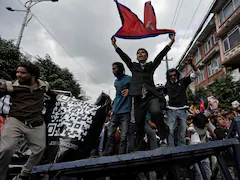

Following the violent Nepal protests, authorities implemented curfews in several key areas of the capital city, including the parliament, president’s residence, and Singha Durbar, which houses the prime minister’s office. Some demonstrators had successfully climbed over parliament walls and vandalized the facility’s main gate during the height of the Nepal protests.
The government deployed army units to contain the unrest, with heightened security measures extending to border regions. The Nepalese government imposed curfews in several regions, including parts of the Terai that borders India, demonstrating the widespread impact of the Nepal protests beyond Kathmandu.
International Response to Nepal Protests
The violent suppression of Nepal protests drew immediate international attention and condemnation. The United Nations demanded a swift and transparent investigation into the government’s response. UN rights office spokeswoman Ravina Shamdasani issued a statement expressing deep concern about allegations of unnecessary or disproportionate use of force by security forces during the Nepal protests.
Amnesty International also called for a comprehensive investigation into the use of live ammunition against demonstrators, highlighting international concern about human rights violations during the Nepal protests.
Deeper Issues Behind Gen-Z Demonstrations
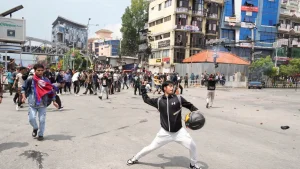

While the Nepal protests initially appeared focused solely on social media restrictions, demonstrators revealed broader motivations for their actions. The ban on platforms like Facebook and Instagram, which have millions of users in Nepal, served as a catalyst for expressing deeper frustrations.
Student activist Yujan Rajbhandari, 24, explained that the Nepal protests addressed institutionalized corruption within the government system. The demonstrations reflected widespread youth dissatisfaction with political governance extending far beyond digital platform access.
“Nepo Kids” Controversy and Social Media Impact
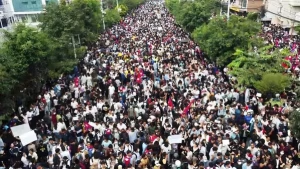
Viral TikTok videos contrasting ordinary Nepalis’ struggles with politicians’ children, dubbed “Nepo Kids” from nepotism, significantly influenced the Nepal protest. These videos showcased luxury goods and expensive vacations enjoyed by political families while regular citizens faced economic hardships.
The stark contrast highlighted by social media content amplified public anger and contributed to the intensity of the Nepal protest, demonstrating how digital platforms serve as crucial tools for political expression and social commentary.
Platform Registration and Compliance Issues
The government had previously blocked Telegram in July citing online fraud and money laundering concerns, followed by a nine-month TikTok ban until August last year. While platforms like Viber, WeTalk, Nimbuzz, and Poppo Live registered under new rules, major platforms including Facebook remained non-compliant.
Meta, Facebook’s parent company, did not respond to registration requirements, leading to the broader restrictions that sparked the Nepal protest.
Border Security and Regional Impact
Security was stepped up in several Uttar Pradesh districts sharing borders with Nepal, indicating regional concerns about potential spillover effects from the Nepal protest. The deployment of army units and implementation of curfews in border regions demonstrated the government’s recognition of the protests’ potential international implications.
The Nepal protest ultimately succeeded in forcing policy reversal, demonstrating the power of youth-led digital activism in contemporary political movements.

